Fort Monroe
| Fort Monroe | |
|---|---|
| U.S. National Register of Historic Places | |
| U.S. National Historic Landmark | |
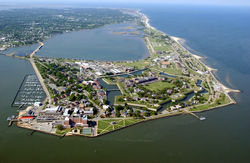 Fort Monroe Aerial Photo 2004
|
|
 |
|
| Location: | Hampton, Virginia |
| Coordinates: | |
| Built/Founded: | 1819 |
| Governing body: | United States Army |
| Added to NRHP: | October 15, 1966 |
| Designated NHL: | December 19, 1960[2] |
| NRHP Reference#: | 66000912 [1] |
Fort Monroe (also known as Fortress Monroe) is a Hampton, Virginia, military installation located at Old Point Comfort, which is on the tip of the Virginia Peninsula. Along with Fort Calhoun, later renamed Fort Wool, it guarded approach by sea of the navigational shipping channel between the Chesapeake Bay and the entrance to the harbor of Hampton Roads, which itself is formed by the confluence of the Elizabeth River, the Nansemond River, and the James River, the longest in Virginia.
During the initial exploration by the mission headed by Captain Christopher Newport in the earliest days of the Colony of Virginia, the site was identified as a strategic defensive location. In May of 1607, they established the first permanent English settlement in the present-day United States about 25 miles further inland from the Bay along the James River at Jamestown. The land area where Fort Monroe is located became part of Elizabeth Cittie [sic] in 1619, Elizabeth River Shire in 1634, and was included in Elizabeth City County when it was formed in 1643. Over 300 years later, in 1952, Elizabeth City County and Fort Monroe's neighbor, the nearby Town of Phoebus, agreed to consolidate with the smaller independent city of Hampton, which became one of the large Seven Cities of Hampton Roads.
Beginning by 1609, fortifications had been established at Old Point Comfort during Virginia's first two centuries. However, the much more substantial facility of stone to become known as Fort Monroe (and adjacent Fort Wool on a man-made island across the channel) were completed in 1834. The principal facility was named in honor of U.S. President James Monroe. Throughout the American Civil War (1861–1865), although most of Virginia became part of the Confederate States of America, Fort Monroe remained in Union hands. It became notable as a historic and symbolic site of early freedom for former slaves under the provisions of contraband policies and later the Emancipation Proclamation. For several years thereafter, the former Confederate President, Jefferson Davis, was imprisoned in the area now known as the Fort Monroe Casemate Museum on the base.
Completely surrounded by a moat, the six-sided stone fort is the only one of its kind left in the United States that is still an active Army post. Fort Monroe is one of several posts selected to be closed by September 2011. Many of its functions are being transferred to nearby Fort Eustis (which itself was named for Fort Monroe's first commander, General Abraham Eustis, a noted artillery expert). Several re-use plans for Fort Monroe after it is decommissioned are currently under development in the Hampton community.
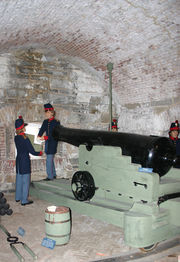
Contents |
History
Colonial Period
Arriving with three ships under Captain Christopher Newport, Captain John Smith and the colonists of the Virginia Company who established the Jamestown Settlement of the British Colony of Virginia on the James River in 1607. On their initial exploration, they recognized the strategic importance of the site at Old Point Comfort for purposes of coastal defense. They initially built Fort Algernourne (1609–1612) at the location of the present Fort Monroe. It is assumed to have been a triangular stockade, based on the fort at Jamestown. Other small forts known as Fort Henry and Fort Charles were built nearby in 1610. Fort Algernourne burned in 1612. In the latter part of August 1619 a Dutch ship, the "White Lion" appeared off the coast of Old Point Comfort. Its cargo, 20 and odd Negroes captured from the slave ship Sao Joao Bautista. These were the first Africans to come ashore on British occupied land in what would become America. Although these first Bantu Africans from Angola were considered indentured servants, it would mark the beginning of slavery in America. Two of the first Africans to arrive at Old Point Comfort in 1619 were Antonio and Isabella. They would give birth to the first African child born in America in January 1624. Another fort, known only as "the fort at Old Point Comfort" was constructed in 1632, and destroyed by a hurricane in 1667. In 1728, Fort George was built on the site. Its masonry walls were destroyed by a hurricane in 1749, but the wood buildings within the fort continued to be used by a reduced force until at least 1775. In 1781, during the siege of Yorktown, the French West Indian fleet established a battery on the ruins of Fort George. Throughout the Colonial period, fortifications were manned at the location from time to time.
Early 19th century
Following the War of 1812, the United States again came to realize the importance of protecting Hampton Roads and the inland waters from attack by sea, and construction was begun in 1819 on what would become the largest stone fort ever built in the United States. The fort, designed by Simon Bernard, features a moat completely surrounding the inner structures. As a young first lieutenant and engineer in the U.S. Army, Robert E. Lee was stationed there from 1831 to 1834, and played a major role in the final construction of both Fort Monroe and its opposite, Fort Calhoun. The latter, later renamed Fort Wool, was built on a man-made island called the Rip Raps across the navigational channel from Old Point Comfort in the middle of the mouth of Hampton Roads. The fort was briefly used to detain Black Hawk.
When construction was completed in 1834, Fort Monroe was referred to as the "Gibraltar of Chesapeake Bay." The fort accomplished this mission by mounting an impressive complement of the most powerful artillery of the time, 32-pounder guns with a range of over one mile. In conjunction with Fort Calhoun (later Fort Wool), this was just enough range to cover the main shipping channel into the area. (Decommissioned after World War II, the former Fort Wool on Rip Raps is now adjacent to the southern man-made island of the Hampton Roads Bridge-Tunnel, initially completed in 1957).
American Civil War
1860–61
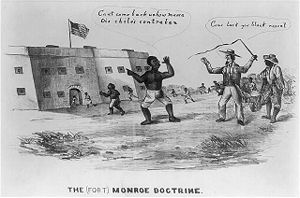
Fort Monroe played an important role in the American Civil War. On December 20, 1860, South Carolina became the first state to secede from the Union. Four months later, on April 12, 1861, troops of that state opened fire on Fort Sumter in Charleston Harbor. Five days later, Virginia's legislature passed (subject to voter's ratification) the Ordinance of Secession of Virginia to withdraw from the Union, and join the newly formed Confederate States of America. On 23 May 1861, voters of Virginia ratified the state's secession from the union.
President Abraham Lincoln had Fort Monroe quickly reinforced so that it would not fall to Confederate forces. It was held by Union forces throughout the Civil War and several sea and land expeditions were launched from there by Union forces.
A few weeks after the Battle of Fort Sumter in 1861, U.S. Army General-in-Chief Winfield Scott proposed to President Abraham Lincoln a plan to bring the states back into the Union: cut the Confederacy off from the rest of the world instead of attacking its army in Virginia. His plan was to blockade the Confederacy's coastline and control the Mississippi River valley with gunboats. In cooperation with the Navy, troops from Fort Monroe extended Union control along the coasts of the Carolinas as Lincoln ordered a blockade of the Southern seaboard from the South Carolina line to the Rio Grande on April 19, and on April 27 extended it to include the North Carolina and Virginia coasts.
On April 20 the Union Navy burned and evacuated the Norfolk Navy Yard, destroying nine ships in the process, leaving only Fort Monroe at Old Point Comfort as the last bastion of the United States in Tidewater Virginia. Occupation of Norfolk gave the Confederacy its only major shipyard and thousands of heavy guns, but they held it for only one year. Confederate Brigadier General Walter Gwynn, who commanded the Confederate defenses around Norfolk, erected batteries at Sewell's Point, both to protect Norfolk and to control Hampton Roads.
The Union dispatched a fleet to Hampton Roads to enforce the blockade, and on May 18–19, 1861, Federal gunboats based at Fort Monroe exchanged fire with the Confederate batteries at Sewell's Point. The little-known Battle of Sewell's Point resulted in little damage to either side. Several land operations against Confederate forces also were mounted from the fort, notably the Battle of Big Bethel in June 1861.
Fort Monroe is also the place at which, on May 27, 1861, Major General Benjamin Butler made his famous "contraband" decision, by which escaping slaves reaching Union lines would not be returned to bondage. The order resulted in waves of enslaved people fleeing to Union lines around Fort Monroe, which was Butler's headquarters in Virginia, and earned Fort Monroe its other nickname of "Freedom's Fortress", as any slave reaching it would be free.
Under Gen. Butler's command, Fort Monroe was the site of a military balloon camp under the flight direction of aeronaut John LaMountain. While the Union Army Balloon Corps was being developed at Fort Corcoran near Arlington under the presidentially appointed Prof. Thaddeus S. C. Lowe, LaMountain, who was also vying for position as Chief Aeronaut, had gained the confidence of Butler in using his balloon Atlantic for aerial observations. LaMountain is accredited with having made the first successful report from an aerial station that was of practical military intelligence. LaMountain was later reassigned to Lowe's balloon corps, but after a period of in-fighting with Lowe he was released from military service. Lowe would eventually assign regular military balloons to Fort Monroe.
1862
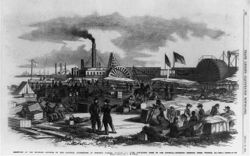
In March 1862, the naval Battle of Hampton Roads took place off Sewell's Point between the first ironclad warships, CSS Virginia and USS Monitor. While the outcome was inconclusive, the battle marked a change in naval warfare and the end to wooden fighting ships.
Later that spring, the continuing presence of the Union Navy based at Fort Monroe enabled Federal water transports from Washington, D.C., to land unmolested to support Major General George B. McClellan's Peninsula Campaign. Formed at Fort Monroe, McClellan's troops moved up the Virginia Peninsula during the spring of 1862, reaching within a few miles of the gates of Richmond about 80 miles to the west by June 1. For the next 30 days, they laid siege to Richmond. Then, during the Seven Days Battles, McClellan fell back to the James River well below Richmond, ending the campaign. Fortunately for McClellan, during this time, Union troops regained control of Norfolk, Hampton Roads, and the James River below Drewry's Bluff (a strategic point about 8 miles south of Richmond).
1864–96
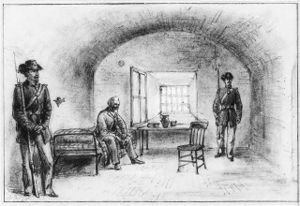
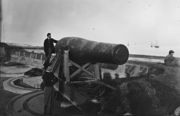
In 1864, the Union Army of the James under Major General Benjamin Butler was formed at Fort Monroe. The 2nd Regiment, United States Colored Cavalry, mustered at Fort Monroe on December 22, 1864, and The 1st Regiment, United States Colored Cavalry mustered the same day at nearby Camp Hamilton. The Siege of Petersburg during 1864 and 1865 was supported on the James River from a base at City Point (now Hopewell, Virginia). Maintaining the control of Hampton Roads at Fort Monroe and Fort Wool was crucial to the naval support Grant required for the successful Union campaign to take Petersburg, which was the key to the fall of the Confederate capitol at Richmond. As Petersburg fell, Richmond was evacuated in 1865 on the night of April 2–3. That night, Confederate President Jefferson Davis and his cabinet escaped Richmond, taking the Richmond and Danville Railroad to move first to Danville and then North Carolina. However, the cause was lost, and Confederate General Robert E. Lee surrendered what was left of the Army of Northern Virginia to Grant at Appomattox Court House the following week.
After the last Confederate cabinet meeting was held on April 26, 1865, at Charlotte, North Carolina, Jefferson Davis was captured at Irwinville, Georgia, and placed under arrest. He was briefly confined in an unheated, open casemate until the Union Surgeon John J. Craven recommended more humane care for Mr. Davis. General Nelson A. Miles approved changes and even moved Mr. Davis to more hospitable quarters. He was held at Fort Monroe for two years. Some historians have speculated that his treatment in captivity was intended to be lethal. In poor health, Davis was released in May, 1867, on bail, which was posted by prominent citizens of both Northern and Southern states, including Horace Greeley and Cornelius Vanderbilt, who had become convinced he was being treated unfairly. The federal government proceeded no further in its prosecution due to the constitutional concerns of U.S. Supreme Court Chief Justice Salmon P. Chase.
The Journal of the United States Artillery was founded at Fort Monroe in 1892 by First Lieutenant (later General) John Wilson Ruckman and four other officers of the Artillery School. Ruckman served as the editor of the Journal for four years (July 1892 to January 1896) and published several articles therein afterward. One publication by West Point notes Ruckman's “guidance” and “first-rate quality” work were obvious as the Journal “rose to high rank among the service papers of the world”. The Journal was renamed the Coast Artillery Journal in 1922 and the Antiaircraft Journal in 1948.
Twentieth century
Over time the armament at Fort Monroe was improved, taking advantage of new technologies. In addition, the fort controlled several sub installations around Hampton Roads, making the area one of the most heavily defended in the United States.
The Jamestown Exposition held in 1907 at Hampton Roads, featured an extensive naval review, including the Great White Fleet. Beginning in 1917, the former exposition site at Sewell's Point became a major base of the United States Navy. Currently, Norfolk Navy Base is the base supporting naval forces operating in the Atlantic Ocean, Mediterranean Sea, and Indian Ocean. It is the world's largest naval station based on supported military population.
Fort Monroe and Fort Wool stood guard during World War I and World War II, and successfully protected Hampton Roads and the important military and civilian resources located inland.
By World War II, Fort Monroe served as headquarters for an impressive array of coast artillery guns ranging from 3-inch rapid fire guns to 16-inch guns capable of firing a 2,000 pound projectile 25 miles. In addition, the Army controlled submarine barriers and underwater mine fields. But this vast array of armaments was all made obsolete after the second World War by the development of the long-range bomber and the aircraft carrier .
After the operational armament was removed, Fort Monroe received a mission that it still maintains to this day. Since World War II, it has served as the major headquarters for training soldiers for war. In 1973, Fort Monroe became home to the United States Army Training and Doctrine Command (TRADOC), which combines the recruitment, training and education of soldiers with the development of operational doctrine.
Fort Monroe today
Fort Monroe supports a daytime population of about 3,096, including 1,105 people in uniform, 1,991 civilian and contract employees, and about 814 family members residing on post. The major tenant unit is the United States Army Training and Doctrine Command (TRADOC).
In addition to continuing to serve as an active military installation, Fort Monroe has become a popular historical site. The Casemate Museum, opened in 1951, depicts the history of Fort Monroe and Old Point Comfort, with special emphasis on the Civil War period. It offers a view of Confederate President Jefferson Davis' prison cell. Also shown are the quarters occupied by 1st Lt. Robert E. Lee in 1831–34, and the quarters where President Abraham Lincoln was a guest in May, 1862. The quarters occupied by Robert E. Lee while stationed at Fort Monroe are still in use as military family housing.
Fort Monroe is the scene of many running events, including for many years, the Shamrock Sportsfest Marathon.
Nearby, Fort Monroe's companion guardian of Hampton Roads, Fort Wool, located at Rip Raps is also available for tours.
Note: Fort Wool is located adjacent to one of the man-made islands of the Hampton Roads Bridge-Tunnel and is accessible only by water. The availability of public tours of both Fort Wool and Fort Monroe are subject to Homeland Security Alert conditions.
Base Realignment and Closure, 2005
The Department of Defense released a list on 13 May 2005, of military installations recommended for closure and/or realignment—among them is Fort Monroe. The list was approved by President George W. Bush on 15 September 2005, and submitted to Congress. Congress failed to act within forty-five legislative days to disapprove the list in its entirety, and the BRAC recommendations subsequently became law. Installations on the BRAC list must close within six years.
Redevelopment possibilities
The Fort Monroe Reuse Plan was officially adopted August, 2008 and it can be viewed on-line at www.fmfada.com. This is the website of the Fort Monroe Federal Area Development Authority which is the official “Local Redevelopment Authority” (LRA) recognized by the Department of Defense. The task of the FMFADA commission is to study, plan and recommend the best use of the resources that will remain when the Army closes the base in September 2011.
The FMFADA relies on the expertise of national consultants in the areas of BRAC law, environmental engineering, historic architecture and preservation planning, structural engineering, housing market analysis, commercial/retail analysis, public relations/marketing, and tourism planning.
The Fort Monroe Federal Area Development Authority (FMFADA) was created by legislative action of the Virginia General Assembly in 2007. Virginia’s Department of Historic Resources and the Department of Environmental Quality have major regulatory authority that influences the work. The state is taking a lead role in planning because most of the land that Fort Monroe occupies will revert to the Commonwealth when the Army closes the base. The effort is guided by three priorities; keep Fort Monroe open to the public, respect the rich history and advance economic sustainability.
The Fort Monroe Federal Area Development Authority (FMFADA) is an 18 member body consisting of appointees from the city of Hampton, the Virginia House of Delegates and Senate and the Virginia governor’s cabinet, with two specialists in historic preservation and heritage tourism.
Generally, surplus military installations are turned over to the respective states. Redevelopment will be facilitated by the fact that most of the land on which the fort stands was loaned by the state of Virginia to the federal government, and will revert to the state once Fort Monroe closes.
Virginia historically has given local government strong consideration in determining disposition at that point, such as occurred at Fort Pickett in Nottoway County (near Blackstone) in the Southside region. Given the historic significance of the post, the decommissioned fort will be a good candidate for heritage tourism along with many other historical sites located throughout the greater Hampton Roads area. Redevelopment to help offset the economic loss of a base closure is usually a priority as well.
Fort Monroe is a National Historic Landmark and the moated fort and the 190 historic buildings on Old Point Comfort will be protected with historic preservation design guidelines for reuse. Old Point Comfort is prime development property and some mixed used new construction will be allowed within strict guidelines. For example, the historic Chamberlin Hotel has already been leased to a developer by the Army and beautifully renovated as retirement apartments.
The National Park Service and the Fort Monroe FADA are communicating to identify the best way to achieve a partnership and several options have been presented to the FMFADA board by the park service. [1] [2]
See also
- Chapel of the Centurion
- Fort Wool
- Sewell's Point
- Battle of Hampton Roads
- United States Army Training and Doctrine Command
References
- ↑ "National Register Information System". National Register of Historic Places. National Park Service. 2007-01-23. http://www.nr.nps.gov/.
- ↑ "Fort Monroe". National Historic Landmark summary listing. National Park Service. http://tps.cr.nps.gov/nhl/detail.cfm?ResourceId=691&ResourceType=District. Retrieved 2008-06-23.
External links
- Fort Monroe official website
- Fort Monroe During the Civil War in Encyclopedia Virginia
- Fort Monroe Federal Area Development Authority
- Fort Monroe, Fortress, Hampton, VA: 57 b&w photos, 1 color photo, at Historic American Building Survey
- Fort Monroe Installation Overview from ArmyUSA.org.
- GlobalSecurity.org Fort Monroe webpage
- Fort Monroe Casemate Museum
- TRADOC website
- U.S. Department of Defense website
- Site for Citizens for a Fort Monroe National Park (CFMNP.org)
- 2nd Regiment, United States Colored Cavalry
- 1st Regiment, United States Colored Cavalry
- Photograph from the Library of Congress collection
- Google Earth KML File
|
||||||||||
|
|||||||||||